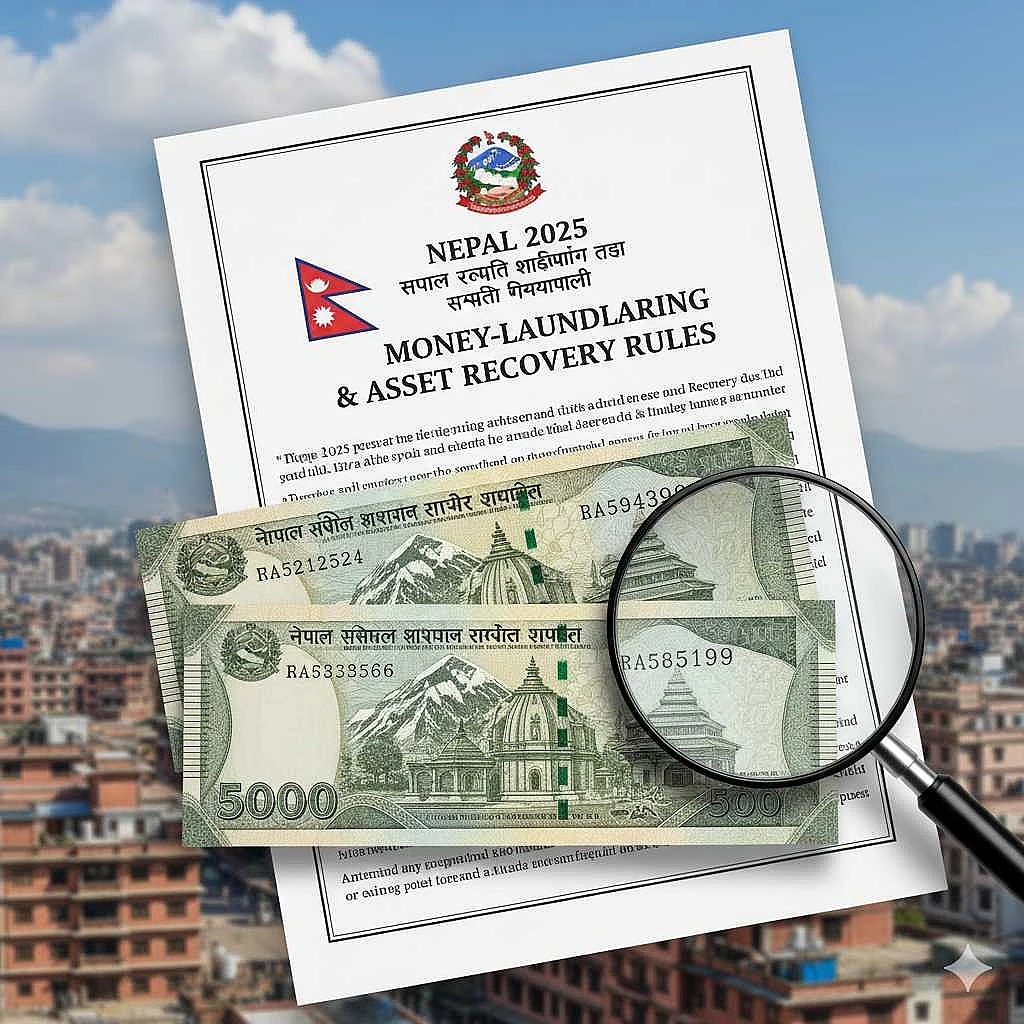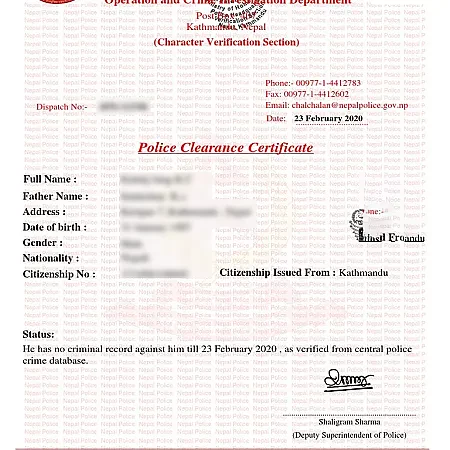Navigating Nepal's 2025 Money-Laundering & Asset Recovery Rules: Essential Guide for Banks and FinTech Companies
Introduction
Nepal's financial sector stands at a pivotal moment with the introduction of the 2025 Money-Laundering & Asset Recovery Rules. These comprehensive regulations represent a significant shift in how financial institutions must approach anti-money laundering (AML) compliance and asset recovery. For banks and FinTech companies operating in Nepal, understanding these changes is not just about regulatory adherence—it's about building more resilient, transparent financial systems that can withstand global scrutiny.
This comprehensive guide breaks down the 2025 Money-Laundering Rules Nepal has introduced, examining their specific implications for different financial entities and providing actionable insights for compliance professionals. Whether you're a traditional bank grappling with legacy systems or a FinTech company navigating digital-first compliance challenges, this resource will help you adapt to the new regulatory landscape effectively.
Understanding the 2025 Money-Laundering & Asset Recovery Rules in Nepal
Background and Context
The 2025 Money-Laundering & Asset Recovery Rules mark Nepal's most significant regulatory update in nearly a decade. These rules align Nepal's financial regulatory framework more closely with international standards set by the Financial Action Task Force (FATF), addressing gaps identified in previous assessments. The Nepal Rastra Bank (NRB) has spearheaded these changes in collaboration with the Financial Information Unit (FIU) and other regulatory bodies.
The timing of these regulations reflects Nepal's commitment to strengthening its financial integrity amid increasing cross-border financial activities and the rapid growth of digital financial services. The 2025 Money-Laundering Rules Nepal has introduced specifically address emerging vulnerabilities in both traditional and digital financial channels.
Key Objectives of the New Regulations
The 2025 Money-Laundering & Asset Recovery Rules pursue several critical objectives:
- Enhanced Detection: Improving the identification of suspicious financial activities across all payment channels
- Strengthened Enforcement: Providing regulators with more robust tools to investigate and penalize non-compliance
- International Cooperation: Facilitating better information sharing with international financial intelligence units
- Asset Recovery: Establishing clearer mechanisms for tracing, freezing, and repatriating illicit funds
- Risk-Based Approach: Implementing more sophisticated risk assessment methodologies tailored to different financial institutions
These objectives collectively aim to transform Nepal's AML compliance landscape from a checkbox exercise to a comprehensive risk management framework that evolves with emerging threats.
Major Changes from Previous Regulations
Enhanced Scope and Definitions
The 2025 Money-Laundering Rules Nepal has introduced significantly expand the definition of "financial institution" to include a broader range of entities. Previously, some digital payment service providers and certain non-banking financial institutions operated in regulatory gray areas. The new rules bring these entities explicitly under the AML compliance umbrella.
Additionally, the definition of "beneficial ownership" has been strengthened to require more detailed identification of individuals who ultimately control or benefit from financial accounts. This change directly impacts how banks and FinTech companies conduct customer due diligence, particularly for corporate accounts and complex ownership structures.
Strengthened Regulatory Oversight
Under the new framework, the Nepal Rastra Bank has been granted expanded supervisory powers, including:
- Authority to conduct on-site inspections without prior notice
- Ability to impose immediate interim measures on institutions suspected of non-compliance
- Enhanced reporting requirements that provide regulators with more granular data
- Mandatory participation in industry-wide AML stress tests
These changes represent a fundamental shift from reactive to proactive supervision, with regulators now able to identify potential compliance issues before they escalate into systemic vulnerabilities.
Impact on Traditional Banking Institutions
Compliance Framework Adjustments
Traditional banks face substantial adjustments to their existing compliance frameworks under the 2025 Money-Laundering Rules Nepal has implemented. The most significant changes include:
- Enhanced Risk Scoring: Banks must now implement more sophisticated customer risk assessment models that incorporate additional factors such as transaction patterns, geographic risks, and business relationships
- Periodic Review Requirements: Customer due diligence must be refreshed more frequently, with high-risk customers requiring review at least annually
- Documentation Standards: All compliance-related documentation must be maintained for a minimum of 10 years, up from the previous 7-year requirement
These adjustments necessitate significant investments in compliance personnel, training programs, and technological infrastructure. Banks with legacy systems face particular challenges in meeting these new requirements without substantial system upgrades.
Operational Implications
The operational impact of the new regulations extends beyond the compliance department:
- Branch-Level Training: Frontline staff must receive enhanced training to identify suspicious activities and understand new reporting requirements
- Product Development: New financial products must undergo AML compliance assessments before launch
- Cross-Border Transactions: International transfers now require additional verification steps and documentation
- Internal Audit: Internal audit functions must expand their scope to include more frequent AML compliance assessments
For many banks, these changes require a fundamental rethinking of how compliance is integrated into daily operations rather than treated as a separate function.
Unique Implications for FinTech Companies
Digital-Specific Challenges
FinTech companies face unique challenges under the 2025 Money-Laundering Rules Nepal has introduced. The digital nature of their services creates specific vulnerabilities that the new regulations directly address:
- Digital Identity Verification: E-KYC processes must now incorporate additional verification layers, including biometric authentication for high-value transactions
- Transaction Pattern Analysis: Algorithms must be enhanced to detect suspicious patterns in real-time, particularly for peer-to-peer transfers and cross-border digital payments
- API Security: Third-party integrations must meet new security standards to prevent exploitation for money laundering purposes
These requirements are particularly challenging for FinTech companies that prioritize user experience and frictionless transactions, as additional verification steps can potentially impact conversion rates.
Adaptation Requirements
FinTech companies must adapt their business models and technology infrastructure to meet the new regulatory expectations:
- Regulatory Technology Investment: Many FinTechs are increasing investment in RegTech solutions that automate compliance processes
- Data Analytics Capabilities: Enhanced data analytics are now essential for identifying suspicious activities across digital platforms
- Cross-Border Compliance: FinTechs operating internationally must navigate multiple regulatory frameworks while maintaining compliance with Nepal's specific requirements
The 2025 Money-Laundering Rules Nepal has implemented essentially require FinTech companies to balance innovation with compliance, a challenge that will likely shape product development in the coming years.
Enhanced Customer Due Diligence and KYC Requirements
New Verification Standards
The 2025 Money-Laundering Rules Nepal has introduced significantly raise the bar for customer due diligence (CDD) and Know Your Customer (KYC) processes. Key changes include:
- Source of Wealth Documentation: High-net-worth individuals must now provide detailed documentation regarding the source of their wealth, not just their income
- Enhanced Politically Exposed Person (PEP) Screening: PEP screening must now include domestic PEPs in addition to international figures
- Adverse Media Checking: Institutions must implement systems to continuously screen customers against adverse media reports
- Transaction Purpose Verification: For certain transaction types, additional verification of the business purpose is now required
These enhanced requirements necessitate more sophisticated onboarding processes and ongoing monitoring systems that can adapt to changing customer risk profiles.
Risk-Based Approach Implementation
The new regulations emphasize a more sophisticated risk-based approach to CDD and KYC:
- Customer Risk Categorization: Institutions must implement more granular risk categorization, with at least five distinct risk levels rather than the traditional three
- Dynamic Risk Assessment: Customer risk profiles must be updated dynamically based on transaction behavior and other relevant factors
- Enhanced Due Diligence Triggers: The rules specify circumstances that automatically trigger enhanced due diligence, such as unusual transaction patterns or high-risk geographic connections
Implementing this sophisticated risk-based approach requires significant investment in technology and personnel training, but ultimately allows institutions to focus their compliance resources more effectively.
Transaction Monitoring and Reporting Obligations
Updated Thresholds and Parameters
The 2025 Money-Laundering Rules Nepal has introduced revise several key transaction monitoring thresholds and parameters:
- Suspicious Transaction Report (STR) Threshold: The threshold for mandatory STR filing has been lowered from NPR 1,000,000 to NPR 500,000 for certain transaction types
- Cross-Border Reporting: All international transfers exceeding NPR 100,000 must now be reported, down from the previous NPR 500,000 threshold
- Structuring Detection: Systems must now detect potential structuring across multiple accounts within the same institution, not just within individual accounts
- Cash Transaction Limits: Daily cash transaction limits have been reduced for certain customer categories
These changes require significant updates to transaction monitoring systems and may increase the volume of reports that financial institutions must file.
Reporting Mechanisms
The new regulations also introduce changes to how suspicious activities must be reported:
- Electronic Filing System: The Financial Information Unit has launched a new electronic filing system with enhanced security features
- Reporting Timeline: The timeline for filing STRs has been reduced from 15 working days to 7 working days from detection
- Feedback Mechanism: The FIU now provides more detailed feedback on filed reports, helping institutions improve their detection capabilities
- Quality Metrics: Institutions are now evaluated based on the quality of their reports, not just the quantity
These changes aim to improve the overall quality and usefulness of suspicious activity reporting, enhancing Nepal's ability to combat financial crime effectively.
Asset Recovery Mechanisms and Procedures
Identification and Freezing
The 2025 Money-Laundering Rules Nepal has implemented establish clearer procedures for identifying and freezing assets suspected to be linked to criminal activities:
- Freezing Orders: The rules specify the exact process for implementing asset freezing orders, including timelines for notification
- Identification Requirements: Institutions must implement systems to identify assets that may be connected to specific individuals or entities under investigation
- Cross-Border Cooperation: The framework establishes clearer protocols for cooperating with international asset recovery efforts
- Documentation Standards: Enhanced documentation requirements ensure proper audit trails for all asset-related actions
These procedures give authorities more effective tools for preserving assets that may ultimately be subject to recovery proceedings.
Repatriation Processes
The new rules also streamline processes for returning recovered assets to their rightful owners or jurisdictions:
- Repatriation Protocols: Clear protocols now govern how assets are returned to foreign jurisdictions following legal proceedings
- Victim Compensation: The framework establishes priority rules for compensating victims when recovered assets are insufficient to cover all claims
- Asset Management: Guidelines for managing seized assets during legal proceedings help preserve their value
- International Agreements: The rules reference specific international agreements that facilitate cross-border asset recovery
These mechanisms position Nepal to participate more effectively in global asset recovery efforts, demonstrating the country's commitment to combating financial crime.
Technology Requirements for Compliance Implementation
Regulatory Technology Solutions
The 2025 Money-Laundering Rules Nepal has introduced implicitly require significant investment in regulatory technology (RegTech) solutions:
- Automated Monitoring: Institutions must implement automated transaction monitoring systems capable of analyzing large volumes of data in real-time
- Machine Learning Capabilities: The rules encourage the use of machine learning algorithms to improve detection of suspicious patterns
- Cloud-Based Solutions: While not explicitly required, the regulations acknowledge the benefits of cloud-based compliance solutions for smaller institutions
- Integration Requirements: Compliance systems must integrate seamlessly with core banking and payment processing platforms
For many institutions, particularly smaller banks and FinTech companies, meeting these technology requirements may require partnerships with specialized RegTech providers rather than developing in-house solutions.
Data Management and Analytics
Effective implementation of the new regulations depends heavily on sophisticated data management and analytics capabilities:
- Data Retention: The rules specify enhanced data retention requirements, with certain data types requiring storage for up to 10 years
- Data Quality Standards: Institutions must implement data quality frameworks to ensure the accuracy and completeness of compliance-related data
- Analytics Capabilities: Advanced analytics are now essential for identifying complex money laundering schemes that might evade traditional rule-based systems
- Reporting Automation: Automated reporting capabilities are necessary to meet the reduced filing timelines for suspicious activity reports
These requirements represent a significant shift toward data-driven compliance, where institutions must leverage technology to meet their regulatory obligations effectively.
Penalties and Consequences for Non-Compliance
Financial Penalties
The 2025 Money-Laundering Rules Nepal has implemented introduce a tiered penalty structure for non-compliance:
- Minor Violations: Administrative warnings and mandatory remediation plans
- Moderate Violations: Financial penalties ranging from NPR 500,000 to NPR 5,000,000
- Serious Violations: Penalties up to NPR 10,000,000 or 2% of annual turnover, whichever is higher
- Repeated Violations: Progressive penalties that increase with each subsequent violation
These penalties represent a significant increase from previous regulations, reflecting the regulator's commitment to ensuring compliance across the financial sector.
Reputational Risks
Beyond financial penalties, non-compliance carries significant reputational risks:
- Public Disclosure: The Nepal Rastra Bank now has authority to publicly disclose institutions that fail to meet compliance standards
- International Blacklisting: Persistent non-compliance could result in Nepal being blacklisted by international bodies, affecting all financial institutions
- Business Restrictions: Severe violations may result in restrictions on certain business activities or international operations
- Director Liability: Individual directors and senior managers may face personal liability for compliance failures
These reputational risks create powerful incentives for institutions to prioritize compliance, even when it requires significant investment.
Implementation Timeline and Transition Period
Key Milestones
The implementation of the 2025 Money-Laundering Rules Nepal has introduced follows a structured timeline:
- January 1, 2025: Official publication of the new rules
- April 1, 2025: Deadline for initial compliance gap assessments
- July 1, 2025: Implementation of enhanced CDD/KYC requirements
- October 1, 2025: Full implementation of transaction monitoring requirements
- January 1, 2026: Complete compliance with all aspects of the new regulations
This phased approach allows institutions to prioritize their compliance efforts and allocate resources effectively over the transition period.
Grace Periods and Extensions
The regulations include specific grace periods and potential extensions:
- System Upgrades: Institutions may apply for extensions of up to 3 months for technology upgrades, subject to regulator approval
- Small Institution Support: Smaller institutions with limited resources may receive additional time for certain requirements
- FinTech Considerations: The regulator has acknowledged that FinTech companies may require additional time to adapt digital platforms
- Phased Implementation: Certain requirements will be implemented in phases to reduce the compliance burden
These accommodations demonstrate the regulator's awareness of the practical challenges institutions face in implementing the new requirements.
Best Practices for Adapting Compliance Programs
Strategic Planning
Successful adaptation to the 2025 Money-Laundering Rules Nepal has introduced requires strategic planning:
- Comprehensive Gap Analysis: Conduct a thorough assessment of current compliance capabilities against new requirements
- Prioritized Roadmap: Develop a prioritized implementation roadmap based on risk and resource availability
- Stakeholder Engagement: Ensure buy-in from senior management and board members for necessary investments
- Cross-Functional Collaboration: Establish cross-functional teams to address compliance challenges that span multiple departments
Institutions that approach compliance strategically will be better positioned to meet the new requirements while minimizing disruption to their business operations.
Staff Training and Development
Human capital remains critical to effective compliance implementation:
- Specialized Training Programs: Develop specialized training programs for different roles within the organization
- Certification Requirements: Consider requiring professional certifications for key compliance personnel
- Continuous Learning: Establish mechanisms for continuous learning as regulations evolve
- Culture of Compliance: Foster a organizational culture where compliance is everyone's responsibility
Investing in human capital ensures that technology investments are supported by knowledgeable staff who can interpret alerts and make appropriate decisions.
Conclusion: Embracing the New Compliance Landscape
The 2025 Money-Laundering & Asset Recovery Rules represent a fundamental transformation of Nepal's AML compliance landscape. While these regulations introduce significant challenges, they also present opportunities for banks and FinTech companies to strengthen their risk management frameworks and build more resilient financial systems.
Successfully navigating this new regulatory environment requires a strategic approach that balances compliance obligations with business objectives. Institutions that view compliance not as a burden but as an opportunity to enhance their operational integrity will be best positioned for long-term success.
As Nepal's financial sector continues to evolve, staying informed about regulatory developments and implementing robust compliance programs will be essential for sustainable growth. The 2025 Money-Laundering Rules Nepal has introduced set a new standard for financial integrity—one that will ultimately strengthen the entire ecosystem and enhance Nepal's position in the global financial community.
Call to Action: Is your institution prepared for the 2025 Money-Laundering & Asset Recovery Rules? Contact our compliance experts today for a personalized gap assessment and implementation roadmap tailored to your specific needs.





-thumb.webp)


-thumb.webp)

